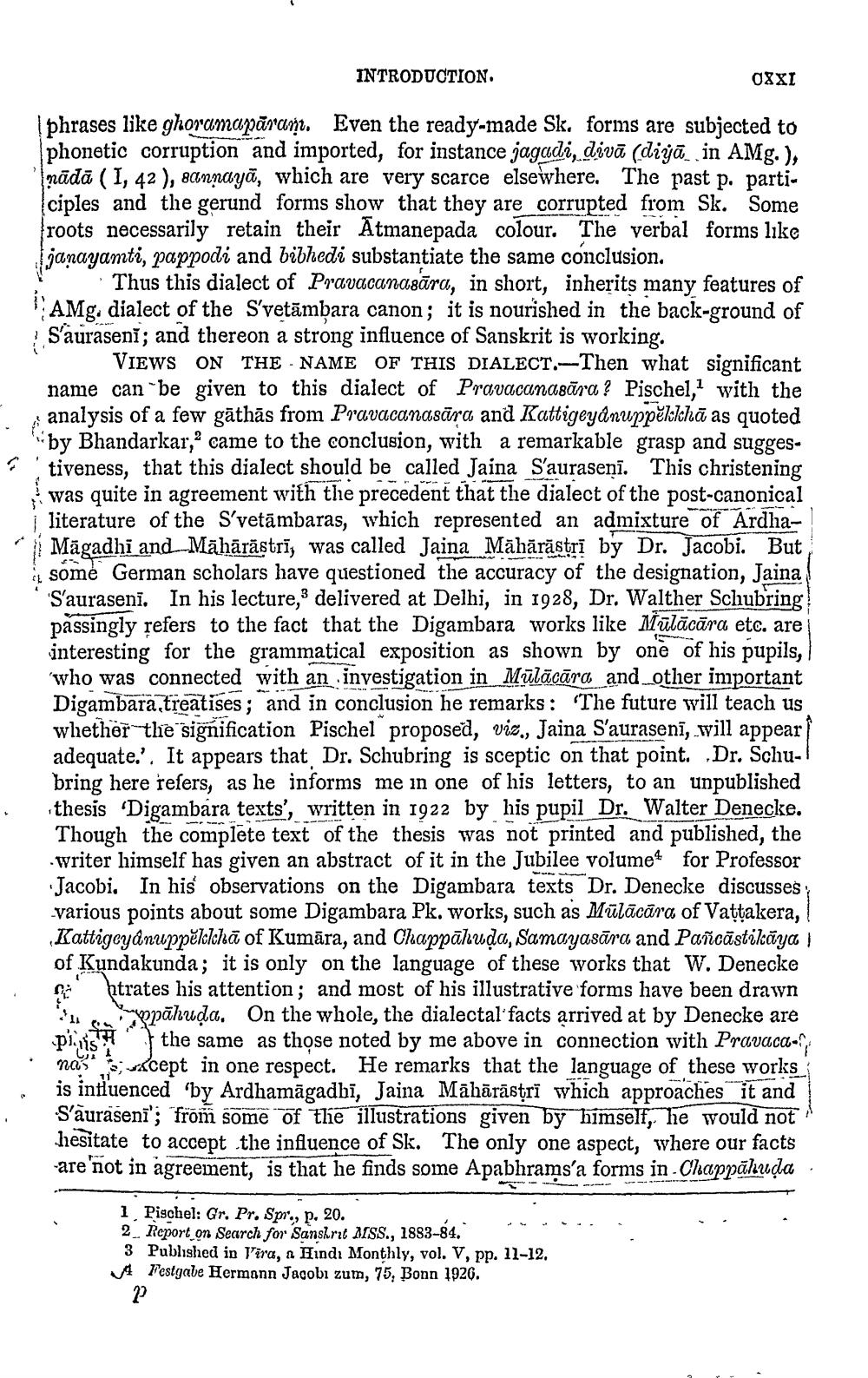________________
INTRODUCTION.
0XXI
janayamti, p
phrases like ghoramapäran. Even the ready-made Sk. forms are subjected to phonetic corruption and imported, for instance jagadi, divā (dijā, in AMg.), rādā (1, 42 ), sannayā, which are very scarce elsewhere. The past p. participles and the gerund forms show that they are corrupted from Sk. Some roots necessarily retain their Atmanepada colour. The verbal forms like Panayamti, pappodi and bibhedi substantiate the same conclusion.
Thus this dialect of Pravacanasāra, in short, inherits many features of AMg, dialect of the S'vetāmbara canon; it is nourished in the back-ground of ? S'aurasenī; and thereon a strong influence of Sanskrit is working.
VIEWS ON THE - NAME OF THIS DIALECT.-Then what significant name can be given to this dialect of Pravacanasāra? Pischel, with the analysis of a few gāthās from Pravacanasāra and Kattigeydnuppekkhā as quoted by Bhandarkar,came to the conclusion, with a remarkable grasp and suggestiveness, that this dialect should be called Jaina Sauraseni. This christening was quite in agreement with the precedent that the dialect of the post-canonical literature of the S'vetāmbaras, which represented an admixture of ArdhaMāgadhi and.-Māhārāstrī, was called Jaina Māhārāstrī by Dr. Jacobi. But some German scholars have questioned the accuracy of the designation, Jaina Saurasenī. In his lecture, 3 delivered at Delhi, in 1928, Dr. Walther Schubring passingly refers to the fact that the Digambara works like Mulācāra etc. are interesting for the grammatical exposition as shown by one of his pupils, who was connected with an investigation in Mülācāra and other important Digambara, treatises; and in conclusion he remarks: The future will teach us whether the signification Pischel proposed, viz., Jaina Saurasenī, will appear adequate.'. It appears that Dr. Schubring is sceptic on that point. Dr. Sc bring here resers, as he informs me in one of his letters, to an unpublished thesis "Digambara texts', written in 1922 by his pupil Dr. Walter Denecke. Though the complete text of the thesis was not printed and published, the writer himself has given an abstract of it in the Jubilee volumet for Professor Jacobi. In his observations on the Digambara texts Dr. Denecke discusses various points about some Digambara Pk. works, such as Mülācāra of Vattakera, Kattigeyânuppěkkehā of Kumāra, and Chappākuda, Samayasāra and Pañcāstikāya Kundakunda; it is only on the language of these works that W. Denecke htrates his attention; and most of his illustrative forms have been drawn
pāhuda. On the whole, the dialectal facts arrived at by Denecke are ping the same as those noted by me above in connection with Pravaca., • nas vcept in one respect. He remarks that the language of these works
influenced by Ardhamāgadbi, Jaina Māhārāstrī which approaches it and Sauraseni ; from some of the illustrations given by himself, he would not hesitate to accept the influence of Sk. The only one aspect, where our facts are not in agreement, is that he finds some Apabhrams'a forms in-Chappāhuca
1 Pigchel: Gr. Pr. Spr., p. 20. 2. Report on Search for Sanskrit MSS., 1883-84. 3 Published in Vira, a Hindi Monthly, vol. V, pp. 11-12. 4 7'estgabe Hermann Jacobi zum, 75, Bonn 1926. 22




